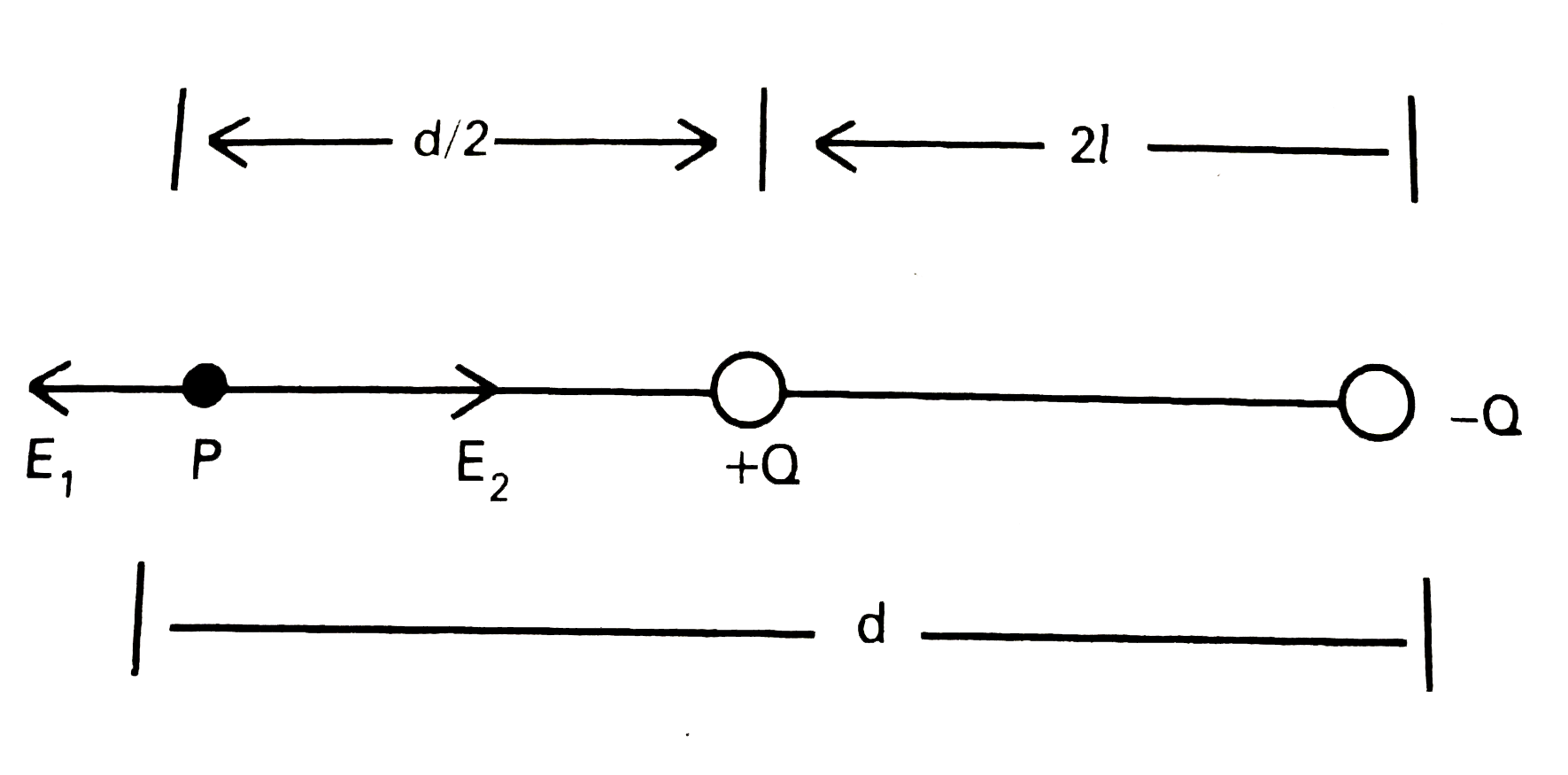An electric dipole consists of two equal and opposite point charge +Q and -Q, separated by a distance 2l. P is a point collinear with the charges such that its distance from the positive charge is half of its distance from the negative charge. Calculate electric intensity at P.Solution in Telugu
Distance of P from −Q=d (say) +Q=d/2
From fig. d=d2+2l
d2=2l
d=4l ...(1)
E1=KQ(d2)2=4KQd2
E2=K(−Q)d2=−KQd2
The electric intensity at P is E=E1+E2
=4KQd2−KQd2⇒e=3KQd2=3×14πε0Q(4l)2
∴E=14πε03Q16l2

Topper's Solved these Questions
- BOOK - VIKRAM PUBLICATION ( ANDHRA PUBLICATION)CHAPTER - ELECTRIC CHARGES AND FIELDSEXERCISE - ADDITIONAL EXERCISES53videos
ELECTRIC CHARGES AND FIELDS
- BOOK - VIKRAM PUBLICATION ( ANDHRA PUBLICATION)CHAPTER - ELECTRIC CHARGES AND FIELDSEXERCISE - DAM SURE VSAQ17videos
ELECTRIC CHARGES AND FIELDS
- BOOK - VIKRAM PUBLICATION ( ANDHRA PUBLICATION)CHAPTER - ELECTRIC CHARGES AND FIELDSEXERCISE - LONG ANSWER QUESTIONS3videos
ELECTRIC CHARGES AND FIELDS
- BOOK - VIKRAM PUBLICATION ( ANDHRA PUBLICATION)CHAPTER - DUAL NATURE OF RADIATION AND MATTEREXERCISE - DAM SURE (VSAQ)2videos
DUAL NATURE OF RADIATION AND MATTER
- BOOK - VIKRAM PUBLICATION ( ANDHRA PUBLICATION)CHAPTER - ELECTROMAGNETIC INDUCTION EXERCISE - Additional EXERCISES15videos
ELECTROMAGNETIC INDUCTION
Similar Questions
What is the force between two small charged soheres having charges of 2×10−7C and 3×10−7C placed 30 cm apart in air ?
03:09View SolutionWhat is meant by the statement 'charge is quantized' ?
01:07View SolutionDefine electric flux. Applying Gauss's law and serive the expression for electric intensity due to an infinite long straight charged wire. (Assume that the electric field everywhere radial and depends only on the radial distance r of the point from the wire.)
12:50View SolutionThe wavelength of electromagnetic radiation is doubled. What will happen to the energy of the photons of the new radiation ?
04:01View SolutionSuppose the loop in Textual Exercise 4 is stationary but the current feeding the electromagnet that produces the magnetic field is gradually reduced so that the field decreases from its initial value of 0.3 T at the rate of 0.02Ts−1 .If the cut is joined and the loop has a resistance of 1.6Ω how much power is dissipated by the loop as heat ? What is the source of this power ?
04:36View SolutionTwo equal charges q of opposite sign are separated by a small distance 2a ,The electric intensity E at a point on the perpendicular bisector of theline joining the two charges at a very large distance r form the line is
03:23View Solution5 कूलॉम आवेश के दो बराबर तथा विपरीत आवेशों के बीच की 5.0 सेमी दूरी है। इसका वैद्युत द्विध्रुव -आघूर्ण है:
03:58View Solutionएकसमान आवेशित छड़ जिसकी लम्बाई 2l तथा कुल आवेश q है, के कारण उसके लम्ब समद्विभाजक पर दूरी r पर स्थित किसी बिन्दु पर विद्युत् क्षेत्र की तीव्रता ज्ञात कीजिए।
04:10View SolutionA point P is at a distance r from a point charge q. if at point P, the electric potential is 300 V, and the electric field intensity is 75 V/m, then the distance of P from the point charge is
02:31View SolutionTwo charges, +qand−q are separated by a distance d. At which points will the resultant electric field intensity be directed parallel to the line joining the charges ?
04:14View Solutionबिन्दु आवेश Q के कारण r दूरी पर विद्युत् क्षेत्र की तीव्रता E है-
07:39View SolutionTwo point charges +10nC and -10nC are separated by a distance of 0.02m. Calculate the electric field intensity at a point P on the axis of the dipole at 0.01 from +10nC .
01:28View SolutionTwo point charges +20nC and −20nC are separated by a distance of 0.10m. Calculate the electric field intensity at a perpendicular distance 0.10 m from the centre of a dipole.
View Solution" Electric field intensity due to a point charge " "q" ' at a distance 'r' from it is "
View SolutionA very small electric dipole with dipole moment p is placed in such in way that it is at a distance r from another point charge +q. The point charge lies on the axis of the dipole . Electric dipole moment is pointing towards the point charge. Determine electric dipole will attract the point charge or repel it ? What will be the magnitude of force between them ?
View Solution

